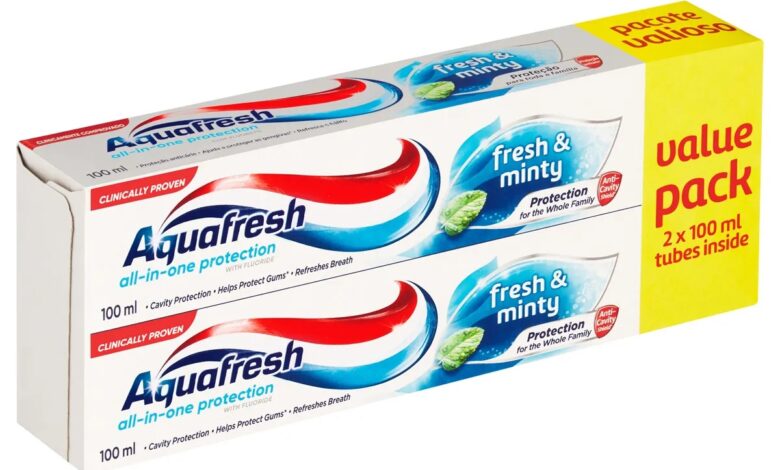Aquafresh: How a Triple-Striped Innovation Redefined Oral Care

Aquafresh: How a Triple-Striped Innovation Redefined Oral Care. For decades, Aquafresh has stood out in the fiercely competitive oral care industry, instantly recognizable by its signature red, white, and blue stripes. More than just a toothpaste, Aquafresh has built a legacy of trust, innovation, and strategic marketing, securing its place in households worldwide. But how did this brand evolve from just another toothpaste to an enduring global success? Through innovation, resilience, and an unwavering commitment to consumer needs, Aquafresh navigated challenges, expanded strategically, and cemented its position as a leader in oral hygiene.
The Birth of an Icon: Aquafresh’s Early Differentiation
Aquafresh debuted in 1973 under the brand Beecham Group, now part of GlaxoSmithKline (GSK). From the outset, it differentiated itself by focusing not just on cavity prevention but on a comprehensive oral care approach. Unlike other toothpastes at the time, which primarily addressed tooth decay, Aquafresh introduced a dual-striped formula—one part for fighting cavities and the other for fresh breath. This bold differentiation set it apart in a crowded market.
However, the most defining moment in Aquafresh’s brand identity came with the introduction of the triple-striped formula in 1983. This addition emphasized three core benefits: cavity protection, fresh breath, and healthy gums. The iconic red, white, and blue stripes became more than just a visual feature; they represented a holistic approach to oral hygiene, making Aquafresh an attractive choice for health-conscious consumers.
Lesson for Entrepreneurs: Find a unique value proposition that resonates with consumer needs. Aquafresh succeeded by offering more than just cavity prevention—it positioned itself as an all-in-one oral health solution.

Strategic Marketing: Making Oral Care Exciting
Aquafresh’s marketing campaigns have been instrumental in sustaining its popularity. Understanding that oral hygiene products can often feel mundane, the brand leveraged bold visuals, engaging storytelling, and relatable messaging to create a lasting impact.
An innovative strategy was its child-focused marketing approach. Recognizing the challenge parents face in encouraging children to brush their teeth, Aquafresh launched kid-friendly products featuring fun flavors and colorful packaging. The introduction of Aquafresh Milk Teeth for toddlers and Aquafresh Big Teeth for older children ensured that the brand catered to every stage of oral development. This strategy created lifelong customers by engaging consumers from an early age.
Lesson for Entrepreneurs: Marketing should not only communicate product benefits but also make them engaging. By tailoring messaging for different demographics, Aquafresh expanded its customer base and built strong brand loyalty.
Resilience Amidst Competition and Changing Consumer Trends
The toothpaste industry is dominated by giants like Colgate, making it a difficult market to penetrate and sustain. Despite this, Aquafresh has remained relevant by continuously adapting to evolving consumer demands.
With rising awareness about natural and fluoride-free products, many consumers began seeking alternatives to traditional toothpaste brands. Rather than resisting the shift, Aquafresh responded with Aquafresh Pure White, a product featuring minimal artificial ingredients while maintaining its core benefits. This ability to evolve without losing its brand identity kept Aquafresh in the game.
Moreover, the brand embraced digital marketing, engaging with consumers via social media and influencer partnerships. Instead of relying solely on traditional advertising, it expanded into digital campaigns that reinforced its core message while adapting to modern consumer habits.
Lesson for Entrepreneurs: Market conditions and consumer preferences will change—resilience and adaptability are key. A brand must be willing to innovate while staying true to its core identity.

Expansion and Global Reach
Aquafresh’s strategic expansion played a crucial role in its global success. Initially focused on Western markets, the brand expanded into Asia, Africa, and Latin America, adjusting formulations and marketing strategies to align with regional preferences. For example, in regions where herbal toothpaste was popular, Aquafresh introduced variations infused with natural ingredients to remain competitive.
Additionally, partnerships with dental professionals and endorsements from health authorities strengthened its credibility worldwide. By positioning itself as a dentist-recommended brand, Aquafresh established trust and continued its dominance in the oral care space.
Lesson for Entrepreneurs: Expanding into new markets requires a localized approach. Understanding cultural preferences and adapting products accordingly can significantly enhance a brand’s success.
Conclusion: The Power of Innovation and Consistency
Aquafresh’s rise to global prominence wasn’t accidental. Through strategic innovation, bold marketing, and a commitment to evolving consumer needs, it carved out a distinct space in a competitive industry. The iconic triple stripes became more than just a branding element—they represented a promise of comprehensive oral care.
For entrepreneurs looking to build successful brands, Aquafresh’s journey offers key takeaways: differentiate boldly, engage consumers effectively, adapt to market shifts, and expand strategically. Success isn’t just about having a great product—it’s about staying relevant, building trust, and continuously delivering value.
Aquafresh proves that even in a saturated market, a brand with a clear mission and strategic execution can achieve enduring success.



